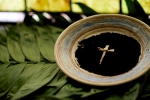November 2012
Liturgy, Music, & Leadership
Follow Me
In 1987, my teenage daughter was attending a Catholic girls school in San Francisco, and she and her schoolmates were recruited to serve as ushers for Pope John Paul II’s Mass at Candlestick Park, the baseball stadium where the Beatles sang their last public concert in 1966.
Each usher was issued a brilliant yellow Papal windbreaker.
The planners who had given a lot of thought to the special platform where the Pope, surrounded by rows of Catholic priests, would stand at the altar, gave less attention to a design for administering communion. When it came time for people to receive the Eucharist, clergy distributed communion from stations located close to the altar platform. People poured into the stadium’s stairs, heading towards the central communion stations. This created chaos as those surging forward to receive communion were blocked by those who had already received and were pushing their way back to their seats.
At 17 my daughter was calling herself a Buddhist, though she attended St. Gregory’s Episcopal for liturgy every Sunday. With a compassionate, problem-solving eye and her good courage (and the authority of a yellow windbreaker bearing the Papal triple crown in red) she pushed through the crowd directing one priest after another to, “follow me.” She led them up and down stairways and stationed them in underserved portions of the stadium: She had no master plan and couldn’t worry about doing it perfectly.
St. Gregory’s helped my skeptical teenaged daughter find enough confidence in her legitimacy as a leader and comfort and ease in the presence of sacrament and ritual that she could help solve the congestion problem during this very large and very public Mass. She’d learned it Sunday by Sunday in a congregation where she saw lay leaders and clergy trusting one another’s judgment in the moment to respond to what was happening, moving things along as planned and simply, without perfectionism, dealing with the surprises that appeared.
But is the liturgy meant to be a place where lay people learn to lead?
I believe it is. With no compromise of our commitment to sacramental reality or holy mystery, we can (and I believe should) shape our congregational practice (what we do together) to form us. With appropriate attention to one another (the gathered Body of Christ) our week-by-week liturgies form us. Together we learn and practice holy courage and blessed, practical creativity.
In “Finding Our Way Again: The Return of the Ancient Practices,” Brian McLaren and Phyllis Tickle tell us people are hungry for spiritual practice, and as they explore the big practices of constant prayer, fasting, liturgical year, sacred journey, sacred meal, Sabbath, and tithing they remind us that the parts and detail of what we do in liturgy are our “communal practice.” I’m suggesting we pay careful attention in our liturgical actions to the actions shared over time that nurture our authority to act freely. In “Just What is Church For?,” I suggest that what church is really for is to enter God’s presence to offer our worship and to find ourselves in Christ, in other words to find our freedom to act gracefully and compassionately.
Contemporary society and culture can make it hard for us to see the formational power of ritual. Haven’t we heard that doing the same thing over and over again is a sure formula for boredom and an invitation to conformity and passivity? Most of us know that the repetition in the liturgy takes us deeper. And what I’ve seen is how the ritual practices of liturgy, what we do together, frees us to be courageous, compassionate, and creative.
I should add to my story that my daughter didn’t learn her resourcefulness for the Papal Mass by serving as an usher or an acolyte in church (though that can be valuable practice too). While she helped out some in Sunday School, she mostly just attended Sunday liturgy (sometimes reluctantly) week by week participating as we all do - finding her place in the assembly, helping visitors find their way through the service and join in, finding her voice as she sang with people, negotiating pitch and rhythm as we all must to sing together, and watching the service unfold and guide us imperfectly toward new dimensions of gathering, listening, speaking, singing, and acting as one.
I’m not talking here about a liturgical ‘style.’ Attention to the practice of congregants can shape our way doing a high church, low church, contemporary, emergent, or whatever other description fits our liturgy. What shared actions in our worship services make it clear to us (without commentary) that we make our worship offering together, respectfully, perhaps sometimes clumsily, without falling into perfectionism?
Martin Luther was convinced that Christian liturgy is meant to teach us. He may have picked that up from Orthodox Churches who also say the liturgy is the center of the church’s teaching work.
I’ve mentioned perfection a couple of times. Learning and graceful formation can’t happen if it’s impossible to risk a mistake. Perfectionism kills learning. A common example - some people avoid offering an explicit welcome to a stranger for fear of welcoming a regular who attends another service or perhaps offending someone who has been away for a while and expects to be recognized. Every time we take this small risk of possible embarrassment, we grow in our practice of attending to the needs of others.
Learning stops when we can’t risk failure. Perfectionism, not repetition, will make ritual numbing to the Spirit.
Whatever your churchmanship, I invite you (lay and clergy) to find the gracious moments of risk in your liturgy, whether they’re for the sake of compassion to a stranger, loving service to a regular, or – did someone ever tell you that you shouldn’t sing? - even risks to help make something beautiful in the worship of God.
Donald Schell is president of All Saints Company, a teaching and consulting foundation serving churches and church leaders. He also serves on the board of Forma, the Episcopal Network for Christian Formation. After work as a college chaplain at Yale and a country vicar in Idaho, he and his wife joined Rick Fabian to found St. Gregory of Nyssa Episcopal Church in San Francisco. He was a founding member of the Coordinating Council of Spiritual Directors International.
Resources
- All Saints Company
- “Finding Our Way Again: The Return of the Ancient Practices,” by Brian McLaren, Phyllis Tickle, et al
- “Just What is Church For?” by Donald Schell
- St. Gregory of Nyssa Episcopal Church, San Francisco
- YouTube clip, Pope John Paul II’s 1996 Mass at Candlestick Park






